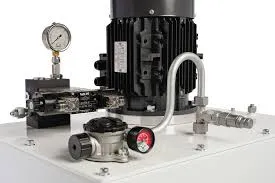Nov . 09, 2024 22:39 Back to list
Custom Power Transfer Units for Enhanced Automotive Performance and Efficiency
Custom Power Transfer Unit in Automotive Applications
In the ever-evolving landscape of the automotive industry, efficiency, performance, and adaptability remain central to vehicle design and engineering. Among the myriad components that engineers continuously innovate, the Power Transfer Unit (PTU) stands out as a pivotal element—especially in vehicles boasting all-wheel drive (AWD) or four-wheel drive (4WD) systems. This article delves into the significance of custom power transfer units (CPTUs) in automotive applications, shedding light on their designs, advantages, and implications for future vehicle technology.
Understanding Power Transfer Units
A Power Transfer Unit is primarily responsible for distributing power from the engine to different wheels. Traditionally, PTUs were designed to handle specific power splits and were often limited by standard configurations. However, custom power transfer units offer engineers the flexibility to tailor these components according to unique vehicle requirements, enhancing overall performance and drivability.
The Need for Customization
The automotive market is witnessing an increasing demand for vehicle personalization and specialization. Whether it's for off-road performance vehicles, high-powered sports cars, or electric hybrid models, the need for PTUs that can be adjusted to suit specific driving conditions has never been greater. A custom power transfer unit allows for
2. Improved Fuel Efficiency By fine-tuning the power distribution, manufacturers can create systems that utilize energy more effectively, potentially leading to reduced fuel consumption and lower emissions—an imperative in today's eco-conscious automotive market.
3. Enhanced Handling and Stability With the ability to tailor the torque split between front and rear axles, custom PTUs can significantly enhance a vehicle's handling characteristics and stability, especially in variable driving conditions.
custom power transfer unit automotive

Design Innovations in Custom PTUs
The design of custom power transfer units has evolved considerably due to advancements in engineering and technology. Many CPTUs utilize advanced materials and manufacturing techniques such as 3D printing, allowing for lighter, stronger, and more compact designs that optimize space and weight within the vehicle. Integration of electronic control systems further enhances their functionality; for instance, smart PTUs can dynamically adjust power distribution in real-time, adapting to road conditions and driver inputs more effectively.
Furthermore, hybrid and electric vehicles have ushered in a new era for PTU design. With the shift from traditional internal combustion engines to electric propulsion, the need for CPTUs that can seamlessly manage power between electric motors becomes crucial. Custom solutions in this arena enable manufacturers to create vehicles that deliver superior acceleration, handling, and energy efficiency.
Challenges and Considerations
While custom power transfer units provide numerous advantages, the development and implementation of these systems are not without challenges. The complexity of designing a PTU that meets specific performance parameters while remaining cost-effective can be daunting. Additionally, the integration of new technologies requires extensive testing and validation to ensure reliability and safety.
Moreover, as the industry progresses towards electrification and automation, CPTU designs must also consider compatibility with emerging technologies such as autonomous driving systems. This evolution necessitates a collaborative approach between engineers, manufacturers, and technology developers to create power transfer systems that are not only advanced but also sustainable.
The Future of Custom Power Transfer Units
Looking ahead, the role of custom power transfer units in the automotive industry is set to expand dramatically. As manufacturers strive to meet stringent environmental regulations and consumer demand for high-performance vehicles, CPTUs will become increasingly integral to vehicle design. Advances in artificial intelligence and machine learning will likely lead to even smarter power distribution systems that optimize performance based on driver behavior and environmental conditions.
In conclusion, custom power transfer units represent a frontier in automotive engineering that can significantly impact vehicle performance, efficiency, and adaptability. As the industry embraces innovation and customization, CPTUs will play a crucial role in shaping the future of driving, providing tailored solutions that enhance the driving experience for diverse consumer needs. As we navigate through this exciting era of automotive technology, the significance of custom power transfer units cannot be overstated.
-
1.5 Ton Flipping Oil Cylinder 70/82-40-217-720 - Hebei Shenghan Hydraulic Machinery Co., Ltd.
NewsSep.01,2025
-
1.5 Ton Flipping Oil Cylinder 70/82-40-217-720-Hebei Shenghan Hydraulic Machinery Co., Ltd.
NewsSep.01,2025
-
1.5 Ton Flipping Oil Cylinder-Hebei Shenghan|Precision&Custom Solutions
NewsSep.01,2025
-
1.5 Ton Flipping Oil Cylinder 70/82-40-217-720-Hebei Shenghan Hydraulic Machinery|Precision Engineering&Customization
NewsSep.01,2025
-
1.5 Ton Flipping Oil Cylinder 70/82-40-217-720 - Hebei Shenghan | Hydraulic Solutions, Customization
NewsSep.01,2025
-
1.5 Ton Flipping Oil Cylinder 70/82-40-217-720 - Hebei Shenghan Hydraulic Machinery Co., Ltd.|Precision Engineering&Customizable Hydraulic Components
NewsSep.01,2025
